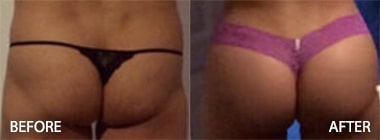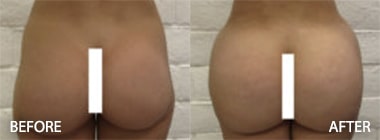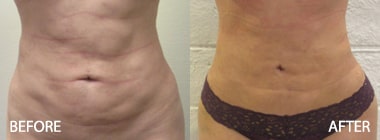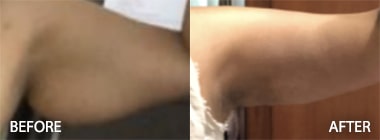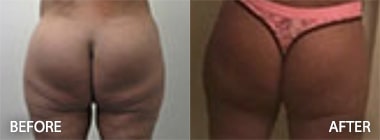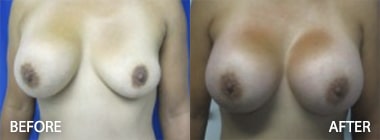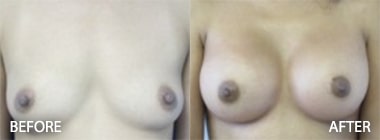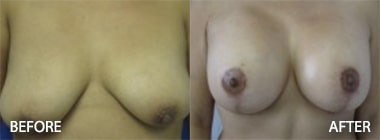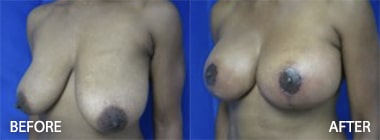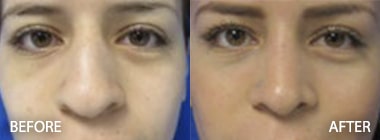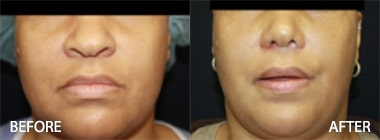Dr. Kenneth Hughes of Hughes Plastic Surgery performs several hundred butt augmentations each year in my practice comprised of both butt implant surgeries and fat transfers or Brazilian butt lifts. Dr. Kenneth B. Hughes frequently lets the patient select whatever form of augmentation they would prefer unless there is a strategic advantage for performing one or another for that individual. For most patients, avoiding the implants is a good long-term rationale. There is no question that the implants feel harder and can have long-term issues including tissue thinning, sagging, and need for replacement or removal. The fat transfer largely avoids the tissue thinning issue and the unnatural feel about which some patients complain.
The downside to the Brazilian butt lift is that the transferred fat can be absorbed up to 50% in some individuals. However it is foolish to say that the transferred fat completely goes away as is frequently promulgated on the internet in articles or websites or patient/doctor blogs. If a person has a great deal of fat around the midsection, for example, liposuction of the abdomen, sides, and lower back can dramatically reduce the waist and give the patient a much more hourglass figure even without the fat transfer.
You can liposuction fat from the lower back to improve the apparent buttock projection. You can even liposuction fat from the posterior thigh in certain cases and produce greater definition and greater buttock projection and roundness. This selective liposuction can be coupled with fat transfer to the buttocks for increased projection and fat transfer to the hips for more of an hourglass figure.
The butt implant surgery by itself of course only augments the buttock and does very little for the hips, and it certainly does not alter any of the fat around the waist. Some patients may only request the buttock implants without liposuction or the fat transfer. Some patients have so little fat that this is not even an option.
The patients who are larger who have more fat around the trunk can obviously benefit from additional liposuction of the abdomen, sides, and lower back as well as possible fat transfer to the hips. Dr. Hughes is frequently asked about whether or not to place hip implants. Though hip implants are easy to place, they almost uniformly produce a poor result. And Dr. Hughes certainly takes a lot of hip implants out or he has to fix the defects caused by the removal of those hip implants. The truth of the matter is is that hip implants are not camouflaged well, because there is very little tissue to cover that implant.
Buttock implants can be placed within the gluteal musculature for effective camouflage. There is so such muscular coverage option with hip implants. As such, the hip implants look “stuck on” or alien. Dr. Hughes has some very happy patients who had hip implants removed with or without fat transfer to the hips as a correction.
For buttock implants, there are a wide array of volumetric sizes from which to choose and two basic shapes of round an oval. Nearly all available options are solid silicone implants, though some are smooth and some are textured. The two largest companies are Implantech and AART. AART was going out of business, but they have been purchased by another company so their implants are still available. Though Dr. Hughes prefers the smoother implants of Implantech, AART produces a 712 round textured implants, which is the largest in production. Dr. Hughes gets many requests from all over the world to place these larger implants.
Overall, the patient to go from a modest improvement with a 200+ ml implant to a rather large improvement with a 712 cc implant. Although there are round and oval implants, the round implants produce a rounder appearance and can give the appearance of hips. An oval implant will never achieve these goals. In fact, the longest axis of the oval implant is in the vertical axis and this can produce a very oval shaped buttock, which can appear masculine. In the many male gluteal augmentation patients Dr. Kenneth Hughes has assisted, the patients also request lateral fullness and roundness as well as projection. There is no question that a lot of volume can be placed with oval implants, but the volume largely goes to waste by placing it in the vertical axis. In addition, oval implants have an additional issue, which is encountered from time to time. The oval implant can rotate within the pocket and can cause distortion. The round implant simply does not have this issue.
The buttock or gluteal implants are typically placed without the muscle to reduce the obviousness in appearance or the feel upon palpation. Some surgeons place gluteal implants in a subfascial position, which certainly shortens surgical time as the dissection is infinitely easier. However, the lack of adequate soft tissue coverage results in a more obvious appearance either right at the outset or over time. In addition, the tissue thinning that occurs can be pronounced and result in a “stuck on” appearance or can result in the implant shifting or descending over time.
So when comparing the Brazilian butt lift surgery with the buttock implant surgery, surgery should be performed to produce the most natural appearance and feel as possible. Admittedly, the buttock implant surgery will never be able to produce the softer result of the Brazilian butt lift surgery. However, with both of these techniques available, buttock implant surgery and fat transfer can be combined at the same time. This can be used to increase buttock projection and volume as well as hip volume. These combinations frequently work out very well and are capable of producing the most dramatic results.
In addition, because Dr. Kenneth Hughes performs so many revision butt implant and Brazilian butt lift surgeries, Dr. Hughes has developed a host of techniques that can solve virtually any issue or accomplish any goal. Pocket corrections with transfer from a subcutaneous plane to an intramuscular plane, correction of pockets that are too large, exchanging implants that are too small or too large, correcting defects from removed implants, fat necrosis, or injections, and transfer of fat to obliterate poor transitions or fill defects are all commonplace surgeries for Dr. Kenneth Hughes.
Utilizing the combination of buttock implant surgery and fat grafting surgery in one form or another can be used to reconstruct virtually any defect for any person with any level of subcutaneous fat.
To learn more about Dr. Kenneth Hughes, Harvard-trained, board-certified plastic surgeon in Los Angeles, please visit
https://www.hughesplasticsurgery.com/los-angeles-kenneth-hughes/
